TANDBERG 3000 MXP User Manual
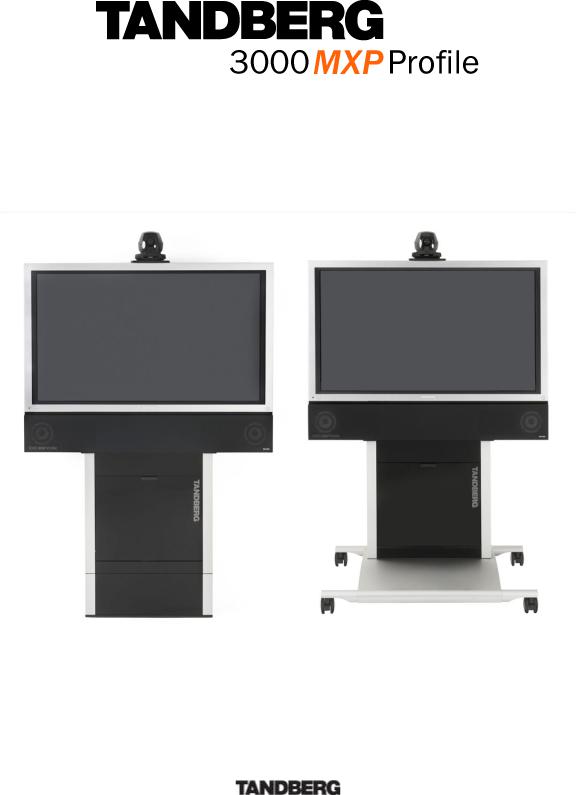
User Manual
Software version F4
D13834.02
This document is not to be reproduced in whole or in part without permission in writing from:
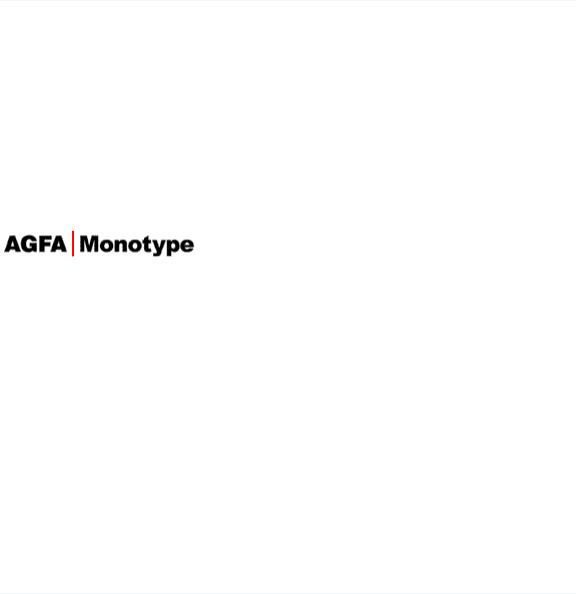
TANDBERG 3000 MXP
Trademarks and Copyright
All rights reserved. This document contains information that is proprietary to TANDBERG. No part of this publication may be reproduced, stored in a retrieval system, or transmitted, in any form, or by any means, electronically, mechanically, by photocopying, or otherwise, without the prior written permission of TANDBERG. Nationally and internationally recognized trademarks and trade names are the property of their respective holders and are hereby acknowledged.
This product includes© software developed by the OpenSSL Project for use in the OpenSSL Toolkit. Copyright 1998-2002 The OpenSSL Project. All rights reserved.
This product includes cryptographic software written by Eric Young. Copyright © 1995-1998 Eric Young. All rights reserved.
Contains iType™ from Agfa Monotype Corporation.
ICU License - ICU 1.8.1 and later COPYRIGHT AND PERMISSION NOTICE Copyright (c) 19952003 International Business Machines Corporation and others All rights reserved.
Disclaimer
The information in this document is furnished for informational purposes only, is subject to change without prior notice, and should not be construed as a commitment by TANDBERG. The information in this document is believed to be accurate and reliable; however TANDBERG assumes no responsibility or liability for any errors or inaccuracies that may appear in this document, nor for any infringements of patents or other rights of third parties resulting from its use. No license is granted under any patents or patent rights of TANDBERG.
This document was written by the Research and Development Department of TANDBERG, Norway. We are committed to maintain a high level of quality in all our documentation. Towards this effort, we welcome you to Contact us with comments and suggestions regarding the content and structure of this document.
COPYRIGHT © 2005, TANDBERG
ii

User Manual
Environmental Issues
TANDBERG visual communication products significantly reduce the need for travel and thereby help reduce various types of pollution™ . TANDBERG recommends the use of low energy peripherals, such as EnergyStar monitors. Thank you for buying a TANDBERG product.
Battery handling
The batteries for the Remote Control are Long Life Alkaline batteries, which means you will need fewer batteries, further benefiting the environment. Please follow the guidelines on the packing material for handling and disposal instructions for the batteries.
Waste handling
This TANDBERG product contains no consumables that require disposal. You should retain the packaging materials in case future shipment is necessary. Please contact your local authorities for information on waste handling and recycling regulations for electronic products.
Production of products
Our factories employ the most efficient environmental methods for reducing waste and pollution. Our designers do their best to ensure TANDBERG products are highly recyclable.
Digital User Manuals
TANDBERG is pleased to announce that it has replaced the printed versions of its User Manuals with a digital CD version. Instead of a range of different user manuals, there is now one CD which can be used with all TANDBERG MXP products. The CD contains a variety of supported languages. The environmental benefits of digital manuals are significant, from saving paper, to reduced weight for shipping. Even the CD itself is recyclable. Not only are they more ecological, digital manuals are more user friendly. A simple web-based search feature helps users directly access the information they need. In addition, this TANDBERG video system now has an intuitive on-screen help function, which provides a range of useful features and tips. If desired, the user manuals on the CD can still be printed locally.
iii
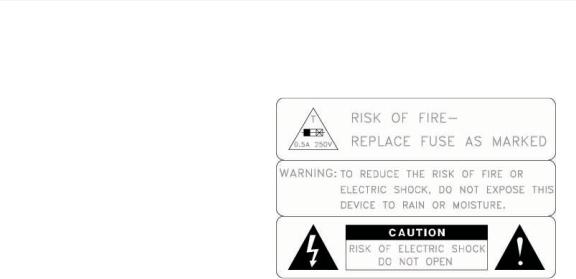
TANDBERG 3000 MXP
Operator Safety Summary
For your protection, please read these safety instructions completely before operating the equipment and keep this manual for future reference. The information in this summary is intended for operators. Carefully observe all warnings, precautions and instructions both on the apparatus and in the operating instructions.
Equipment Markings
The lightning flash symbol within an equilateral triangle is intended to alert the user“ to the presence”of uninsulated ’ dangerous voltages within the product s enclosure that may be of sufficient magnitude to constitute a risk of electrical shock.
The exclamation mark within an equilateral triangle is intended to alert the user to the presence of important operating and maintenance (servicing) instructions accompanying the equipment.
Warnings
Water and moisture - Do not operate the equipment under or near water - for example near a bathtub, kitchen sink, or laundry tub, in a wet basement, or near a swimming pool
or in areas with high humidity.
Cleaning - Unplug the apparatus from the wall outlet before cleaning or polishing. Do not use liquid cleaners or aerosol cleaners. Use a lint-free cloth lightly moistened with water
for cleaning the exterior of the apparatus.
Ventilation - Do not block any of the ventilation openings of the apparatus. Install in accordance with the installation instructions. Never cover the slots and openings with a cloth or other material. Never install the apparatus near heat sources such as radiators,
heat registers, stoves, or other apparatus (including amplifiers) that produce heat. Grounding or Polarization - Do not defeat the safety purpose of the polarized or grounding-type plug. A polarized plug has two blades with one wider than the other. A grounding type plug has two blades and a third grounding prong. The wide blade or third prong is provided for your safety. If the provided plug does not fit into your outlet, consult
an electrician.
Power-Cord Protection - Route the power cord so as to avoid it being walked on or pinched by items placed upon or against it, paying particular attention to the plugs,
receptacles, and the point where the cord exits from the apparatus.
Attachments - Only use attachments as recommended by the manufacturer. Accessories - Most systems should only be used with a cart, stand, tripod, bracket, or table specified by the manufacturer, or sold with the apparatus. When a cart is used, use
caution when moving the cart/apparatus combination to avoid injury from tip-over. Lightning - Unplug this apparatus during lightning storms or when unused for long periods of time.
iv
User Manual
ISDN cables - CAUTION - To reduce the risk of fire, use only No. 26 AWG or larger
telecommunication line cord.
Servicing - Do not attempt to service the apparatus yourself as opening or removing covers may expose you to dangerous voltages or other hazards, and will void the
warranty. Refer all servicing to qualified service personnel.
Damaged Equipment - Unplug the apparatus from the outlet and refer servicing to qualified personnel under the following conditions:
When the power cord or plug is damaged or frayed
If liquid has been spilled or objects have fallen into the apparatus
If the apparatus has been exposed to rain or moisture
If the apparatus has been subjected to excessive shock by being dropped, or the
cabinet has been damaged
If the apparatus fails to operate in accordance with the operating instructions
v

TANDBERG 3000 MXP
Contact us
If you have any questions, comments or suggestions, please see the Online Support section at www.tandberg.net.
It is also possible to send a fax or mail to the attention of:
Product and Sales Support
TANDBERG
P.O. Box 92
1325 Lysaker
Norway
Tel: +47 67 125 125
Fax: +47 67 125 234
vi
User Manual
Table of Contents
1 |
Introduction............................................................................................................................... |
1 |
||
|
1.1 |
At a Glance ............................................................................................................................ |
4 |
|
|
1.2 |
Menu Structure ...................................................................................................................... |
6 |
|
2 |
Installation ................................................................................................................................ |
8 |
||
|
2.1 |
Unpacking and Mounting ....................................................................................................... |
9 |
|
|
2.2 |
Connecting Cables............................................................................................................... |
11 |
|
|
2.3 |
Monitor Configuration........................................................................................................... |
12 |
|
|
2.4 |
System Configuration........................................................................................................... |
13 |
|
3 |
General Use ........................................................................................................................... |
16 |
||
|
3.1 The Welcome Screen .......................................................................................................... |
17 |
||
|
3.2 |
Using the Remote Control.................................................................................................... |
18 |
|
|
3.2.1 |
Navigation ................................................................................................................ |
22 |
|
|
3.2.2 |
Selfview.................................................................................................................... |
23 |
|
|
3.2.3 |
Layout ...................................................................................................................... |
25 |
|
|
3.2.4 |
Mic Off...................................................................................................................... |
26 |
|
|
3.2.5 |
Volume + and - ........................................................................................................ |
27 |
|
|
3.2.6 |
Number and Letter keys........................................................................................... |
28 |
|
|
3.2.7 |
Touch Tones ............................................................................................................ |
29 |
|
|
3.3 |
On-screen Indicators............................................................................................................ |
30 |
|
|
3.4 |
Using the Menu.................................................................................................................... |
32 |
|
|
3.5 |
Make a Call .......................................................................................................................... |
34 |
|
|
3.5.1 |
Place Video Call....................................................................................................... |
35 |
|
|
3.5.2 |
Place Telephone Call............................................................................................... |
36 |
|
|
3.5.3 |
Add Call ................................................................................................................... |
37 |
|
|
3.5.4 |
Call Settings............................................................................................................. |
39 |
|
|
3.5.5 |
Streaming................................................................................................................. |
40 |
|
|
3.6 |
Answer an incoming call ...................................................................................................... |
42 |
|
|
3.7 |
End Call................................................................................................................................ |
43 |
|
|
3.8 |
Standby ................................................................................................................................ |
44 |
|
|
3.8.1 |
Delay Standby for 1 hour ......................................................................................... |
45 |
|
|
3.8.2 |
Delay Standby for 3 hours ....................................................................................... |
46 |
|
|
3.8.3 |
Do Not Disturb ......................................................................................................... |
47 |
|
|
3.9 |
Phone Book.......................................................................................................................... |
48 |
|
|
3.9.1 |
Call Log.................................................................................................................... |
49 |
|
|
3.9.2 |
My Contacts ............................................................................................................. |
50 |
|
|
3.9.3 |
Global Contacts ....................................................................................................... |
57 |
|
|
3.10 Camera Control.................................................................................................................. |
61 |
||
|
3.10.1 |
Move Camera .......................................................................................................... |
62 |
|
|
3.10.2 |
Far End Control........................................................................................................ |
63 |
|
|
3.10.3 |
Camera Presets ....................................................................................................... |
64 |
|
|
3.10.4 |
TANDBERG Tracker................................................................................................ |
65 |
|
|
3.10.5 |
Picture Control ......................................................................................................... |
66 |
|
|
3.10.6 |
Camera Tracking ..................................................................................................... |
67 |
|
|
3.11 Presentation ....................................................................................................................... |
68 |
||
|
3.11.1 |
Presentation Key...................................................................................................... |
69 |
|
|
3.11.2 |
Presentation Menu................................................................................................... |
70 |
|
|
3.11.3 |
PC Presenter (DVI/XGA Input) ................................................................................ |
71 |
|
|
3.11.4 |
PC Soft Presenter and VNC .................................................................................... |
72 |
|
|
3.11.5 |
Dual Stream (DuoVideoTF/H.239)........................................................................... |
73 |
|
|
3.11.6 |
Take New Snapshot................................................................................................. |
74 |
|
|
3.11.7 |
Display Snapshot ..................................................................................................... |
75 |
|
vii
TANDBERG 3000 MXP |
|
|
3.12 Conference Services.......................................................................................................... |
76 |
|
3.12.1 |
Request Floor and Release Floor............................................................................ |
79 |
3.12.2 |
Conference Layout................................................................................................... |
80 |
3.12.3 |
Terminal Names....................................................................................................... |
81 |
3.12.4 |
Chair Control............................................................................................................ |
82 |
3.12.5 |
Assign Floor and Release Floor from Participant .................................................... |
83 |
3.12.6 |
View Site and End View........................................................................................... |
84 |
3.12.7 |
Disconnect Participant ............................................................................................. |
85 |
3.12.8 |
Terminate Meeting ................................................................................................... |
86 |
3.12.9 |
More about MultiSite (embedded MCU) .................................................................. |
87 |
3.13 Control Panel ..................................................................................................................... |
88 |
|
3.13.1 |
Diagnostics .............................................................................................................. |
89 |
3.13.2 |
System Information .................................................................................................. |
90 |
3.13.3 |
Channel Status ........................................................................................................ |
91 |
3.13.4 |
Call Status................................................................................................................ |
92 |
3.13.5 |
System Selftest ........................................................................................................ |
93 |
3.13.6 |
View Administrator Settings ..................................................................................... |
94 |
3.13.7 |
IP Address Conflict Check ....................................................................................... |
98 |
3.13.8 |
Warnings.................................................................................................................. |
99 |
3.13.9 |
Text Chat ............................................................................................................... |
101 |
3.13.10 |
Audio Demo....................................................................................................... |
102 |
3.13.11 |
Administrator Settings ....................................................................................... |
103 |
3.13.12 |
Restart ............................................................................................................... |
104 |
3.13.13 |
User Guide ........................................................................................................ |
105 |
4 Administrator Settings .......................................................................................................... |
106 |
|
4.1 General Settings ................................................................................................................ |
107 |
|
4.1.1 |
Language ............................................................................................................... |
108 |
4.1.2 |
System Name ........................................................................................................ |
109 |
4.1.3 |
International Name................................................................................................. |
110 |
4.1.4 |
Auto Answer........................................................................................................... |
111 |
4.1.5 |
Phone Book Settings ............................................................................................. |
112 |
4.1.6 |
External Services Settings ..................................................................................... |
113 |
4.1.7 |
Permissions ........................................................................................................... |
114 |
4.1.8 |
Screen Settings...................................................................................................... |
116 |
4.1.9 |
Software Options ................................................................................................... |
122 |
4.1.10 |
Date and Time Settings ......................................................................................... |
123 |
4.2 Menu Settings .................................................................................................................... |
124 |
|
4.2.1 |
Input Editor Language............................................................................................ |
125 |
4.2.2 |
Menu Timeout In Call............................................................................................. |
126 |
4.2.3 |
Menu on TV ........................................................................................................... |
127 |
4.2.4 |
Menu on PC ........................................................................................................... |
128 |
4.2.5 |
Balloon Help........................................................................................................... |
129 |
4.2.6 |
Administrator Password ......................................................................................... |
130 |
4.2.7 |
Kiosk Mode Settings .............................................................................................. |
131 |
4.2.8 |
Startup ................................................................................................................... |
134 |
4.2.9 |
Icons....................................................................................................................... |
136 |
4.3 Presentation Settings......................................................................................................... |
137 |
|
4.3.1 |
Presentation Start .................................................................................................. |
138 |
4.3.2 |
H.239...................................................................................................................... |
139 |
4.3.3 |
Startup Video Source............................................................................................. |
140 |
4.3.4 |
Presentation Source .............................................................................................. |
141 |
4.3.5 |
Snapshot Source ................................................................................................... |
142 |
4.3.6 |
Auto-Display Snapshot .......................................................................................... |
143 |
4.3.7 |
PIP Appearance..................................................................................................... |
144 |
4.3.8 |
PIP Placing ............................................................................................................ |
145 |
4.3.9 |
VNC Settings ......................................................................................................... |
146 |
viii
|
|
|
|
User Manual |
|
4.4 |
Call Quality......................................................................................................................... |
147 |
|
|
4.4.1 |
Video Algorithm ...................................................................................................... |
148 |
|
|
4.4.2 |
Audio Algorithm ...................................................................................................... |
149 |
|
|
4.4.3 |
AAC - LD 128kbps (stereo audio) ............................................................................ |
150 |
|
|
4.4.4 |
Natural Video ......................................................................................................... |
151 |
|
|
4.4.5 |
Max Upstream Rate (kbps) .................................................................................... |
152 |
|
|
4.4.6 |
Video Quality .............................................................. |
Error! Bookmark not defined. |
|
|
4.4.7 |
Default Call Settings .............................................................................................. |
156 |
|
|
4.5 |
Audio |
.................................................................................................................................. |
159 |
|
4.5.1 ..................................................................................................................... |
Inputs |
160 |
|
|
4.5.2 .................................................................................................................. |
Outputs |
164 |
|
|
4.5.3 .......................................................................................................... |
Echo Control |
166 |
|
|
4.5.4 ...................................................................................................... |
Stereo Settings |
167 |
|
|
4.5.5 ........................................................................................... |
Audio Levelling (AGC) |
169 |
|
|
4.5.6 ........................................................................................ |
Alert Tones and Volume |
170 |
|
|
4.6 |
Video .................................................................................................................................. |
|
171 |
|
4.6.1 ......................................................................................... |
Camera Tracking Mode |
172 |
|
|
4.6.2 .................................................................................................... |
MCU Status Line |
173 |
|
|
4.6.3 ................................................................................................ |
Floor to Full Screen |
174 |
|
|
4.6.4 ...................................................................................................... |
Web Snapshots |
175 |
|
|
4.6.5 ........................................................................................... |
MultiSite Picture Mode |
176 |
|
|
4.6.6 ........................................................................................................... |
Video Name |
178 |
|
|
4.7 |
Security .............................................................................................................................. |
179 |
|
|
4.7.1 .............................................................................................................. |
Encryption |
180 |
|
|
4.7.2 .................................................................................................... |
Encryption Mode |
181 |
|
|
4.7.3 ............................................................................................................. |
Passwords |
182 |
|
|
4.8 |
Network .............................................................................................................................. |
183 |
|
|
4.8.1 ................................................................................................. |
ISDN - BRI Settings |
184 |
|
|
4.8.2 .......................................................................................................... |
LAN Settings |
186 |
|
|
4.8.3 ..................................................................................................... |
Network Profiles |
205 |
|
|
4.8.4 ................................................................................................................ |
Data Port |
206 |
|
|
4.8.5 ............................................................................................. |
Camera Port Settings |
207 |
|
|
4.8.6 ........................................................................................ |
Restore Default Settings |
208 |
|
5 |
Peripheral ...........................................................................................................Equipment |
209 |
||
|
5.1 |
Interfaces ........................................................................................................................... |
210 |
|
|
5.1.1 ...................................................................................................................... |
Video |
210 |
|
|
5.1.2 ...................................................................................................................... |
Audio |
214 |
|
|
5.1.3 .................................................................................................................. |
Network |
216 |
|
|
5.1.4 ................................................................................................................ |
Data port |
216 |
|
|
5.1.5 ........................................................................................................... |
Camera Port |
218 |
|
|
5.2 Document .............................................................................................................Camera |
220 |
||
|
5.3 DVD / .........................................................................................................................VCR |
221 |
||
|
5.4 |
Additional ............................................................................................................Cameras |
223 |
|
|
5.5 |
Additional ......................................................................................................Microphones |
224 |
|
|
5.6 The TANDBERG .............................................................................DNAM and Speakers |
225 |
||
|
5.7 |
Stereo .............................................................................................................Speaker Kit |
229 |
|
|
5.8 |
Telephone .............................................................................................................Add-On |
231 |
|
|
5.9 |
Dual Monitor....................................................................................................................... |
232 |
|
|
5.10 XGA ..........................................................................................Monitors and Projectors |
233 |
||
|
5.11 VESA .................................................................................Display Power Management |
234 |
||
|
5.12 Digital .................................................................................Monitor Power Management |
235 |
||
|
5.13 Extended ...................................................................Display Identification Data (EDID) |
236 |
||
6 |
Appendices........................................................................................................................... |
238 |
||
|
6.1 |
Appendix .........................................................................................................................1 |
239 |
|
|
6.2 |
Appendix .........................................................................................................................2 |
242 |
|
|
6.3 |
Appendix .........................................................................................................................3 |
245 |
|
ix
TANDBERG 3000 MXP |
|
|
|
6.4 Appendix 4 ......................................................................................................................... |
246 |
|
6.5 Appendix 5 ......................................................................................................................... |
248 |
|
6.6 Appendix 6 ......................................................................................................................... |
251 |
|
6.7 Appendix 7 ......................................................................................................................... |
252 |
|
6.8 Appendix 8 ......................................................................................................................... |
253 |
|
6.9 Appendix 9 ......................................................................................................................... |
254 |
|
6.10 Appendix 10 ..................................................................................................................... |
255 |
|
6.11 Appendix 11 ..................................................................................................................... |
256 |
|
6.12 Appendix 12 ..................................................................................................................... |
258 |
|
6.13 Appendix 13 ..................................................................................................................... |
260 |
|
6.14 Appendix 14 ..................................................................................................................... |
261 |
|
6.15 Appendix 15 ..................................................................................................................... |
263 |
|
6.16 Appendix 16 ..................................................................................................................... |
269 |
|
Appendix 17 ............................................................................................................................. |
270 |
|
6.17 Appendix 18 ..................................................................................................................... |
275 |
7 |
Glossary ............................................................................................................................... |
277 |
8 |
Index..................................................................................................................................... |
287 |
x

1 Introduction
Audio Quality
High-performance audio provides a richer, more complete visual communication experience. The MPEG4 AAC-LD standard is used to provide true standards-based CD-quality, stereo audio.
Users can record and send stereo audio from stereo presentation and playback sources using PCs, DVDs and VCRs using the proper cables.
NEW Eliminate disturbance from GSM mobile phones and Blackberry devices
Video Quality
which ensure high quality video includes:
Natural VideoTF which provides a 60 fields per second true interlaced picture.
Support for H.264 in MultiSite, DuoVideo/H.239 and encryption.
SXGA input and XGA output through DVI-I (analog or digital).
H.264 video compression up to 2Mbps. Support for native 16:9 Wide XGA monitors by increasing the resolution to 1280x768Features
|
(WXGA). |
|
Automatic use of WXGA format when ”VGA Monitor Format” is set to Wide. |
NEW |
HD Support on all TANDBERG MXP systems with a DVI input and output |
NEW |
High quality video and native 16:9 formats |
Network
The system supports videoconferencing via both IP and ISDN networks. The bandwidth
are:
up to 2Mbps* per call
up to 2.3Mbps* total for a MultiSite conference. SIP support, for both point-to-point and MultiSite*.capabilities
If channels are dropped during a videoconferencing session, downspeedingTF automatically maintains connections without interruption.
Security
Secure ConferenceTF provides embedded encryption for both Point-to-Point and MultiSite call and ensures both privacy and security.
The system is delivered with integrated Expressway™ firewall traversal technology. When used
together with a TANDBERG Border Controller it enables: |
|
|
Secure and seamless traversal of ANY firewall. |
|
No missing features when traversing the firewall – works with H.264, MPEG4 audio, |
encryption.
1
TANDBERG 3000 MXP
Outside systems, such as home offices, to be part of the enterprise dial plan.
Dialing to systems by URI, e.g. user@company.com.
NEW |
H.460, ITU Standardized firewall traversal, support |
NEW |
High security network authentication (802.1x) |
MultiSite*
The embedded MultiSiteTF functionality can cater for up to 4 video sites and 3 audio sites and supports screen layouts such as VoiceSwitched, AutoSplit, 4 Split and 5+1 Split. The optional embedded MultiSite functionality supports any combination of ISDN and IP participants in a conference (up to the total).
Superior quality and reliability in MultiSite calls is ensured by the systems support for: |
|
|
DuoVideo/H.239 to provide for presenting full PC resolution information |
|
AES and DES encryption to provide security |
|
H.264 video algorithm to provide the best video at all bandwidths |
|
Rate matchingTF to support different call rates for all sites in a MultiSite |
|
TranscodingTF to support different protocols for all sites in a MultiSite. |
The TANDBERG videoconferencing system can also be used as an audio telephone bridge (assuming ISDN connection(s)).
Presentations
The Natural Presenter Package* (NPP) makes it possible to include PC presentations in
and comprises:
Digital ClarityTF which transmits exceptionally high-quality, native resolution video. Duo VideoTF/H.239 which allows participants at the far end to simultaneously watch a presenter on one screen and a live PC presentation in native resolution on a second
monitor (up to SXGA on compatible monitors).
PC PresenterTF which allows a PC connection via standard DVI/VGA cable supporting up
to SXGA resolution.
PC SoftPresenterTF which shows PC images via a LAN connection supporting XGA
resolution.
Auto Layout to automatically choose the best layout for the call.
PC Zoom which allows the native resolution PC image to be zoomed in/out with the remote control to get SXGA resolution.videoconferences
Users can display video and presentations in the best layout based on the situation. Supported
screen |
|
layouts are: |
|
|
Picture in Picture (PiP) |
|
|
Picture outside Picture (PoP) |
|
|
Side by Side |
User interfaces |
|
A web-interface to the codec provides: |
|
|
System management, diagnostics and software uploads. |
|
Text chat/closed captioning. |
2

Introduction
Unicast Streaming – which allows broadcasting™ of audio/video™ via an IP network to a single compatible client (RealMedia or Apple Quicktime ) or streaming server.
TheOn-Screen Menu:
Provides an easy interface for first-time users with symbols and descriptions. Builds upon the familiar current interface.
NEW |
Enhanced language support with Asian and non-Latin character text input in the |
||
|
menu for local language system names |
||
NEW |
Support |
|
for new optional remote control |
|
|
|
improved usability |
|
|
|
separate ordering |
NEW |
Simplified on-screen menu, Kiosk Mode, for special purposes |
||
The remote control has a simplified look and feel, an auto system wake-up when picked up, and large, easy-to-read keys.
Interoperability
The TANDBERG 3000 MXP Profile is worldwide compatible with other standards-based videoconferencing systems.
* - optional feature. To check which options are installed, select Control Panel - System Information in the menu. TF - TANDBERG First
3
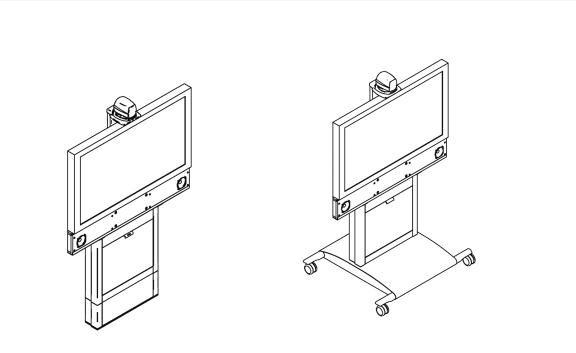
TANDBERG 3000 MXP
1.1 At a Glance
TANDBERG 3000 MXP Profile Wall |
TANDBERG 3000 MXP Profile Roll About |
Mount |
|
Camera
The camera cables are put through the camera bracket, which is then mounted on top of the monitor. The main camera is fastened to the camera bracket. The main camera includes a high quality color’ camera with a fast pan/tilt/zoom action. The main camera is controlled by the system s infra-red remote control and operates pan/tilt, focus and zoom.
Monitors
The monitor displays the far-end and near-end videoconferencing sites in addition to the menus, video from connected video sources and high-resolution images.
Note that the TANDBERG 3000 MXP Profile is shipped with different monitors depending on which configuration is ordered. There are”two ” ” different configurations of the”system: 32 , which has a 32 LCD monitor and the 43 configuration, which has a 43 plasma monitor. Hence, the
pictures/drawings used in this manual might differ from the actual monitor model shipped with the system.
Codec
The codec is the heart of the system. Its main task is the compression of outgoing video, audio and data, the transmission of this information to the far end, and the decompression of the
4
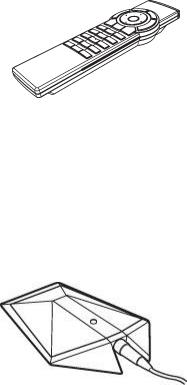
Introduction
incoming information. The name codec comes from a combination of the two words compression and decompression.
Column and Base
The Roll About system is easily movable due to large wheels and handles, at the back of the monitor. The codec is located inside the bracket assembly behind the monitor. Inside the column assembly, there is room for additional equipment, e.g. a VCR or a DVD player.
Remote Control
The remote control is used to control all functions of the system. The remote control uses 4 AAA batteries. The system will tell you when batteries are running low. Change the batteries at the back of the remote control.
The reach of the remote control signal is 20 meters (65 feet). The remote control IR receiver is located on the WAVE II camera. For users working in an open environment with multiple systems deployed, this can cause other systems to respond to your remote control. Use the little white switch placed under the batteries to change the reach of the signal from 20 meters (65 feet) to 2 meters (6.5 feet). This will prevent you from unintentionally controlling another video system when you control your own system.
If the screen saver is activated (black monitor), wake up the system by picking up the remote control.
Microphone
The high quality table microphone is designed to be placed on a table during a videoconference. Up to three microphones can be connected. The ideal location for the microphone is on a flat surface at least 2m (6.5 ft) from the front of the system. The microphone cable should always point towards the system. The system will automatically equalize sound levels. Loud and soft voices are picked up and transmitted to the far end at approximately the same level.
5
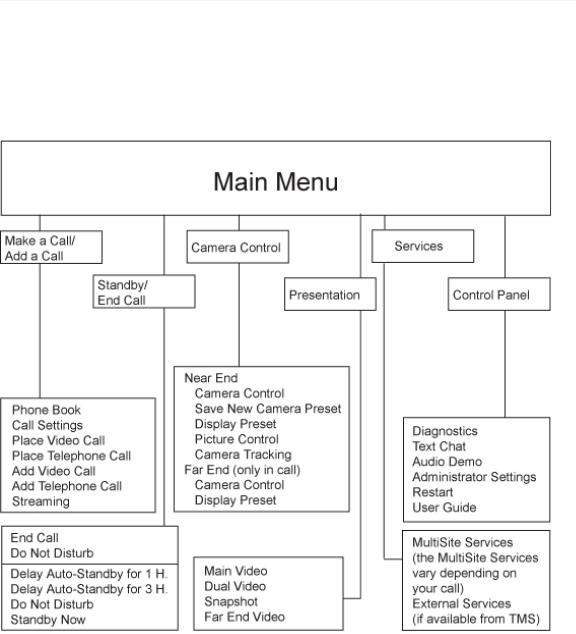
TANDBERG 3000 MXP
1.2 Menu Structure
The menu structure is divided into two parts. The Main Menu is available for all users and contains all the functionality of the system. The Administrator Menu contains all the settings of the system. The Administrator Settings are accessible from the Main Menu by selecting Control Panel and Administrator Settings. Making changes to the Administrator Settings will change the behavior of the system. The menu structure for Main Menu and Administrator Settings is shown below.
6
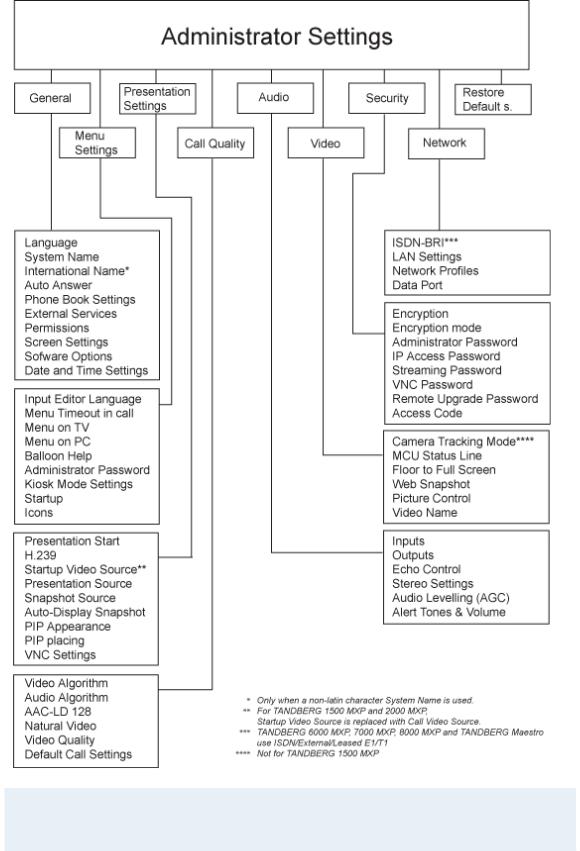
Introduction
Note that the system features and menu settings may vary depending on network selection and software package.
7

2 Installation
Precautions:
Never install communication wiring during a lightning storm.
Never install jacks for communication cables in wet locations unless the jack is
specifically designed for wet locations.
Never touch uninstalled communication wires or terminals unless the telephone line has
been disconnected at the network interface.
Use caution when installing or modifying communication lines.
Avoid using communication equipment (other than a cordless type) during an electrical
storm. There may be a remote risk of electrical shock from lightning.
Do not use the communication equipment to report a gas leak in the vicinity of the leak.
Always connect the product to an earthed socket outlet.
The socket outlet shall be installed near to the equipment and shall be easily accessible.
Never install cables without first switching the power OFF.
1TR6 network type is not approved for connection directly to the telecommunications network. This network type is only to be used behind a PABX.
This product complies with directives: LVD 73/23/EC, EMC 89/366/EEC, R&TTE 99/5/EEC
8
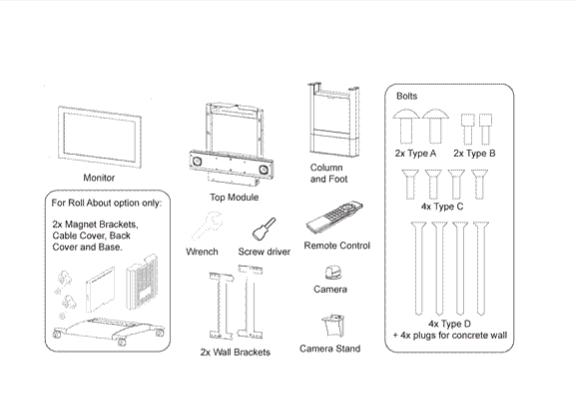
Installation
2.1 Unpacking and Mounting
Unpacking
To avoid damage to the unit during transportation the system is delivered as separate components:
System
Column and Foot
Base, optional
High quality monitor
Wall Brackets
Camera
Camera stand
The Accessories box contains the following:
Screws
ISDN cables
Table Microphone
Remote Control
Documentation
Mounting
Please refer to the Installation sheet provided with the system for details on how to mount the TANDBERG 3000 MXP Profile.
9

TANDBERG 3000 MXP
Note! The camera should be aligned with the front edge of the monitor to ensure that the IRsensor in the camera can pick up the signals from the remote control.
10

Installation
2.2 Connecting Cables
All cables needed for a standard configuration are already connected to the codec. Connect these cables to their respective parts of the system.
1. Power cables
Connect the power cable to an electrical distribution socket.
2. Monitor cables
Connect the DVI cable to the input on your monitor.
3. Microphone cables
Connect the microphone cable to the microphones.
4. Camera cable “ ”
Connect the camera cable labeled Main“ Cam to the S-”Video connector on the camera. Connect also the control cable labeled Camera Control between the RJ-45 on the camera, and the Camera Port on the codec.
5. PC cable
Connect the PC cable to the PC.
6. ISDN cables
Connect the ISDN cables to the ISDN sockets (S/T interface) provided by the network provider. The main ISDN number will be that number associated with the socket to which ISDN cable number 1 has been connected.
Note! The system does not have a built-in network terminator. If wall socket provides an ISDN U-interface, an NT1 between your system and the ISDN line is needed, see Appendix 10 for more information.
7. LAN cable
To connect the system to a Local Area Network (LAN), connect the cable labeled "LAN Ethernet" to a suitable Ethernet port on the LAN.
11

TANDBERG 3000 MXP
2.3 Monitor Configuration
The monitor is pre-configured and only needs to be switched on.
12
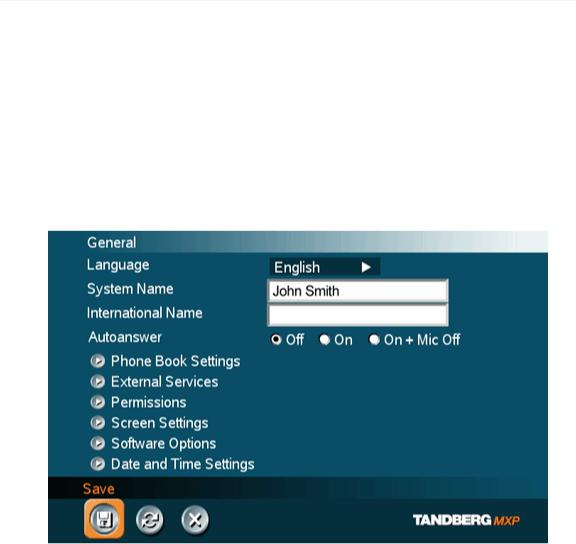
Installation
2.4 System Configuration
The system must be configured for each installation. Configuration settings can be made via the system menu.
Navigate through the menu system using the arrow keys and OK. Remember to press the Save button on the bottom of each menu to save the changes. Press Cancel (x) to return to the previous Menu. See General Use for more information about how to use the menus and the remote control.
General configuration:
1. Open the General Settings menu
Press OK/Menu to open the Main Menu, if not already displayed. Select Control Panel - Administrator Settings - General to open the General Settings menu.
2. Language
Press OK in the Language field and select the desired language from the list.
3. System Name / International Name*
Enter a name in the System Name field using the number keys on the remote control, in the same way as with a mobile or cellular phone. Hold down the # key for one second to switch back and forth from numbers to alpha characters.
4. Dual Monitor
If using one monitor, set Dual Monitor to "Off".
5. Auto Answer, Phone Book Settings, External Services Settings and
Permissions
13
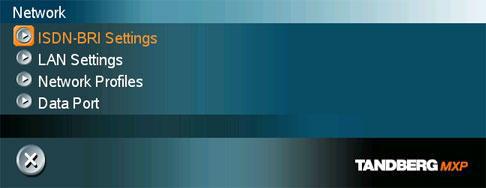
TANDBERG 3000 MXP
These settings may be left unchanged if no special needs are required. See chapter General Settings for more information.
6. Screen Settings
When using wide screen (16:9) monitors, set TV Monitor Format to Wide (16:9). TANDBERG also recommends setting Picture Layout to Picture outside Picture when using 16:9 monitors. Picture outside Picture provides a display layout optimized for wide screen monitors. The display layout may be changed at any time using the Layout button on the remote control.
7. Software Options
This menu item will display the currently installed options (such as MultiSite, Presenter and high bandwidth options). To activate any
purchased software option for the system, an option key must be obtained and then entered into the Software Options menu (see paperwork accompanying the system for“ option keys). The” MultiSite and Presenter option keys should be entered“ under New Option Key” . Any bandwidth option keys should be entered under New Bandwidth Key . You may need to restart the system for options to take effect. For more information on these options, please contact your TANDBERG representative.
8. Date and Time Settings
Select your preferred Date and Time Settings.
9. Save changes
Remember to select the on-screen Save icon on the bottom of each menu (highlight using arrows and use the OK button to select) to save the changes you may have made.
Network configuration:
1. Open the Network menu
Press OK/Menu to open the Main Menu, if not already displayed. Select Control Panel - Administrator Settings - Network to open the Network menu.
2. ISDN configuration
Set the Network type to the desired network. Specify the settings for the selected network in the relevant menu. For details, follow the instructions in ISDN-BRI Settings. See also the examples in Appendix 9: Connecting the system to the Switched 56 network and in Appendix 10: Connecting the system to ISDN using NT1 network adapters.
3. LAN configuration
14
Installation
Select LAN Settings in the Network menu and specify the necessary LAN settings according to the instructions from your LAN administrator. For details, follow the instructions in LAN Settings. If there is an H.323 Gatekeeper present on your LAN, refer to H.323 Settings as well.
4. Network Profiles
Please refer to Network Profiles for details
5. Data Port
Please refer to Data Port for details
6. Save changes
Remember to save any changes made in the menu by selecting the Save button on the Menu line and pressing OK.
* This field is only visible if the system name contains Asian and non-Latin character text input.
15

3 General Use
Wake up the system
When the system is not in use, it is in standby mode and the screen is black. This is to help protect the monitor display. Wake up the system by picking up the remote control. An incoming call or pressing any key on the remote control will also wake up the system.
If the system does not respond:
Make sure that the system is switched on by using the On/Off switch located at the rear
of the Codec.
Verify that your monitor is switched on. This is normally done by pushing the power button on the front of the monitor depending on monitor type. Please reference the user guide for the monitor that was shipped with your system.
16
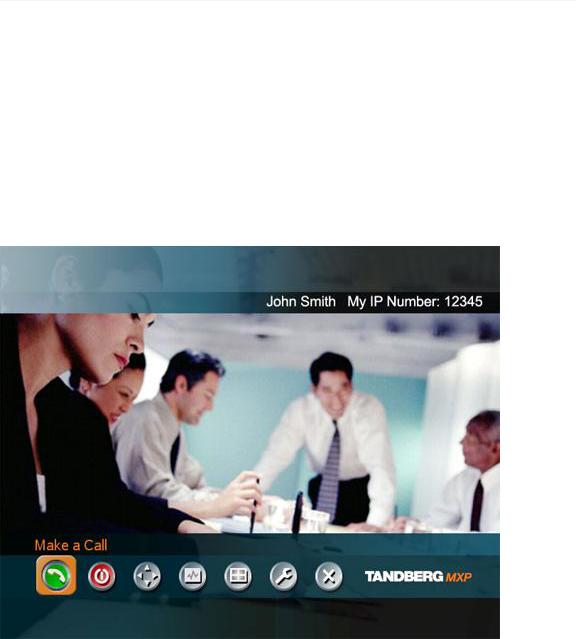
General Use
3.1 The Welcome Screen
When the system is switched on, the welcome screen will be displayed. The welcome screen presents the menu and displays your main camera image in the background (display main camera is the default setting). The ISDN/IP numbers and the system name are displayed in the upper right corner. The ISDN Number and IP Number are the dial-in numbers of the system.
The welcome screen provides you with the most important system information:
System Name
Your ISDN Number
Your IP Address or IP Number
Indications of Missed Calls or Warnings if any
It is possible to customize the text on the welcome screen. See Menu Settings for how to edit the welcome text.
17
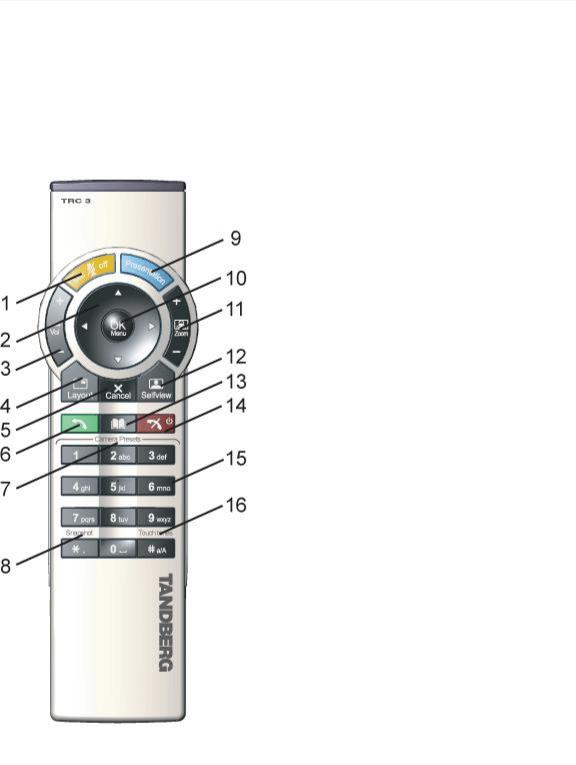
TANDBERG 3000 MXP
3.2 Using the Remote Control
The system is controlled with a remote control. Think of the remote control as a mobile phone with number keys and’ call keys. Use the arrow keys and press OK to navigate through the menus. The system s most commonly used functions are also accessible directly from the remote control. The Infra Red (IR) sensor for the remote control is located in front of the WAVE II Camera. There is also a second IR-sensor located in the front of the Codec itself, which will be automatically enabled if the WAVE II Camera is not connected.
The remote control (TRC 3)
1. |
Mic Off turns your microphone on and |
|
off, see Mic off. |
2. |
Arrow keys are used for navigation in |
|
the menu and for moving the camera* |
|
when the menu is hidden, see |
|
Navigation. |
3. |
Volume + and – adjusts the Codec |
|
volume only and not the monitor's |
|
volume, see Volume + and -. |
4. |
The Layout key toggles between full |
|
screen and different display layouts, see |
|
Layout. |
5. |
Cancel takes you back one step in the |
|
menu system. Use Cancel to delete |
|
characters in an input field, see |
|
Navigation. Press and hold the Cancel |
|
key for 1 second to close the menu. |
6. |
Press the Call key to place a call, see |
|
Make a Call. |
7. |
Camera presets define specific camera |
|
positions. Move the camera to the |
|
desired position and press and hold a |
|
number key for 1 second to save the |
|
current camera position to that number |
|
key. To activate a preset whilst in a call, |
|
simply press and release that number |
|
key, see Camera Presets. |
8. |
Snapshot takes a snapshot of your video |
|
only while you are in a call, see Take |
|
New Snapshot. |
9. |
The Presentation key switches to a |
|
predefined presentation source. If the |
|
Presentation key is held down for 1 |
|
second then the Presentation video |
|
sources menu will appear, see |
|
Presentation Key. |
10. |
Press OK/Menu to show the menu and |
|
to select menu items, see Navigation. |
18
General Use
11. Use Zoom + and – to zoom the camera in and out.*
12. Selfview displays your outgoing video. Press Selfview again to turn selfview off, see Selfview.
13. Use the Phone Book to store and recall video contacts for easy placement of calls, see Phone Book.
14. Use the red End Call key to end the current call. Pressing this key when not in a call will place the system in Standby mode, see End Call and Standby.
15. Number/Letter keys function in the same manner as with a mobile or cellular phone, see Number and Letter keys.
16. Press Touch tones when you are in a call and need to dial extension numbers etc. (instead of presets). Press the OK/Menu button to exit Touch Tones, see Touch tones.
*This does not apply to all systems with small integrated cameras.
19
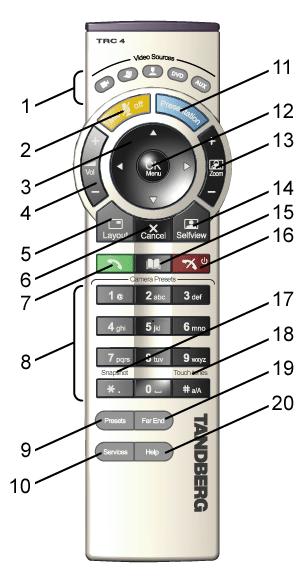
TANDBERG 3000 MXP
The remote control (TRC 4)**:
1. |
Change video source. If |
|
possible, you will start open a |
|
Dual Stream. Press the video |
|
source button again to stop |
|
the dual stream. |
2. |
Mic Off turns your microphone |
|
on and off, see Mic off. |
3. |
Arrow keys are used for |
|
navigation in the menu and for |
|
moving the camera* when the |
|
menu is hidden, see |
|
Navigation. |
4. |
Volume + and – adjusts the |
|
Codec volume only and not |
|
the monitor's volume, see |
|
Volume + and -. |
5. |
The Layout key toggles |
|
between full screen and |
|
different display layouts, see |
|
Layout. |
6. |
Cancel takes you back one |
|
step in the menu system. Use |
|
Cancel to delete characters in |
|
an input field, see Navigation. |
|
Press and hold the Cancel |
|
key for 1 second to close the |
|
menu. |
7. |
Press the Call key to place a |
|
call, see Make a Call. |
8. |
Number/Letter keys function |
|
in the same manner as with a |
|
mobile or cellular phone, see |
|
Number and Letter keys. |
|
Camera presets define |
|
specific camera positions. |
|
Move the camera to the |
|
desired position and press |
|
and hold a number key for 1 |
|
second to save the current |
|
camera position to that |
|
number key. To activate a |
|
preset whilst in a call, simply |
|
press and release that |
|
number key, see Camera |
|
Presets. |
9. |
Press Preset + a number to |
|
activate a preset. |
10. |
Press the Services button to |
|
open the Services menu. |
11. |
The Presentation key |
|
switches to a predefined |
20
